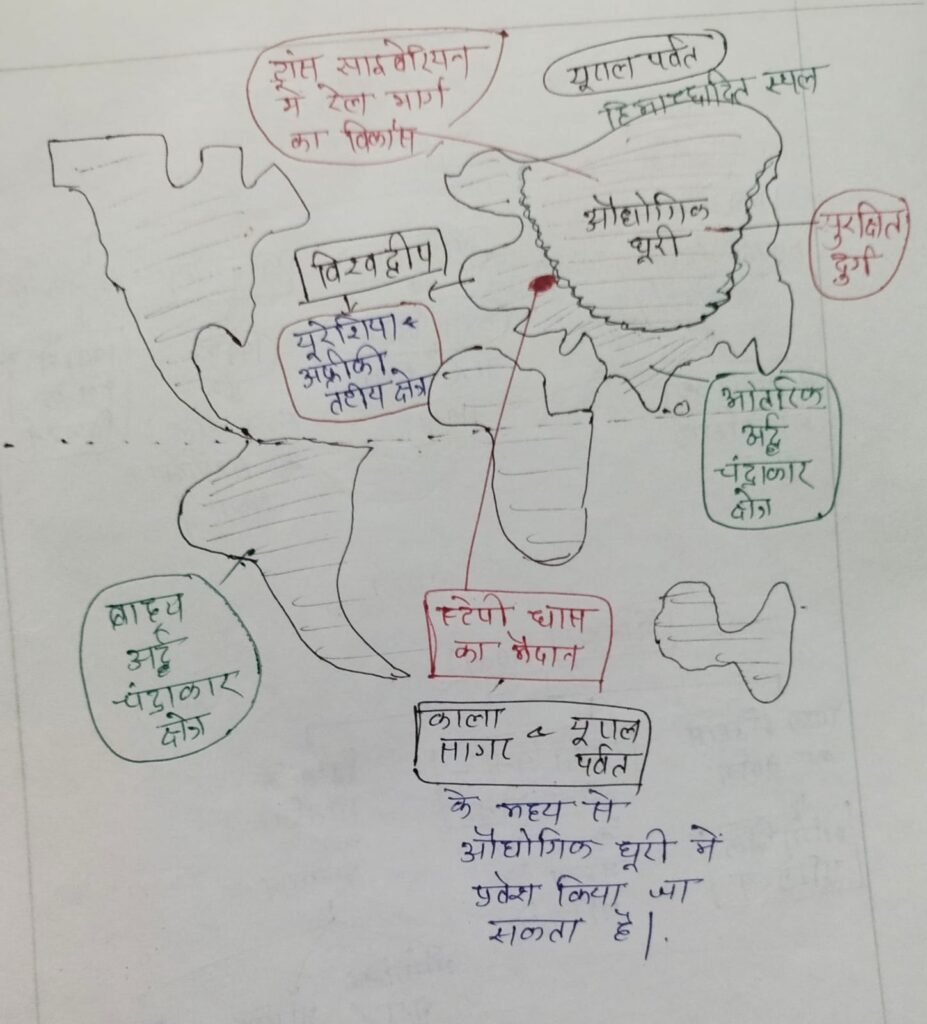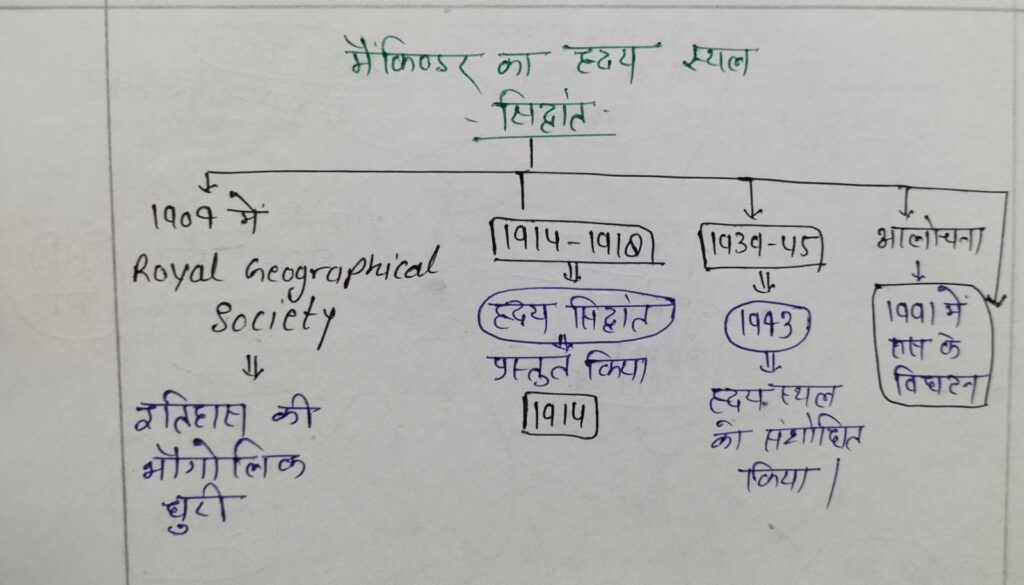The Heartland Theory, also known as Mackinder’s Heartland Theory, is a geopolitical theory proposed by British geographer and politician Halford Mackinder in 1904.

The theory states that the control of the “Heartland,” which Mackinder defined as the large landmass of Eastern Europe and Asia, would be the key to world domination. Mackinder believed that whoever controlled the Heartland would have the resources and military power to rule the world.
According to Mackinder, the Heartland was the “pivot area” of world politics, as it was strategically located at the center of the world’s landmass and surrounded by the “World Island,” which included Europe, Asia, and Africa. He argued that sea power, represented by the naval powers of Britain and the United States, was not enough to control the world, as the Heartland could be easily defended itself against sea-borne invasions.
The Heartland Theory had a significant impact on 20th-century geopolitical thinking and continues to be studied and discussed by scholars and policymakers today. It has been used to explain the geopolitical strategies of various countries, including the Soviet Union, and is often cited in discussions of contemporary international relations.
However, the theory has also been criticized for its Eurocentric and deterministic perspectives, as well as its assumptions about the relationship between geography and power. Nevertheless, the Heartland Theory remains an important part of the historical and theoretical foundations of modern geography and political science.
Why is the Heartland Important?
The Heartland, also known as the Midwest, is considered important for a number of reasons:

Agricultural production:
The Heartland is known for its fertile soil, favorable climate, and abundant water sources, making it a major agricultural producer in the United States. The region produces a significant portion of the country’s corn, wheat, soybeans, and other crops.
Manufacturing:
The Heartland is home to many of the largest manufacturing centers in the United States, including the automobile industry. This region is responsible for producing a significant portion of the country’s manufactured goods, including steel, machinery, and other products.
Energy production:
The Heartland is rich in natural resources, including coal, natural gas, and oil, making it a major energy-producing region. This energy is used to power homes, businesses, and industries across the country.
Transportation hub:
The Heartland is strategically located near the center of the country and is home to many major transportation hubs, including airports, railroads, and highways, making it an important gateway to the rest of the country.
Cultural significance:
The Heartland is also known for its rich cultural heritage, including its diverse communities and unique traditions. The region has a strong sense of community and history, and is often seen as the epitome of the American heartland.
Overall, the Heartland is an important region for the United States, both economically and culturally, and its contributions to the country cannot be underestimated.
Makinder’s heartland theory Criticism
Halford J. Mackinder’s “Heartland Theory” is a geopolitical theory that suggests that the control of the Heartland, or the interior of Eurasia, would give the power to control the world. However, the theory has faced several criticisms over the years:
Obsolescence:
Mackinder’s theory was developed in the early 20th century, and many argue that it is now outdated in light of the rapid changes in technology and global politics since then.
Eurocentric perspective:
The theory is seen as having a Eurocentric perspective, as it assumes that Europe and the United States are the only significant players in global politics. This perspective fails to take into account the rise of other countries, such as China and India, as major players in the world.
Over-simplification:
The theory oversimplifies the complexities of global politics by suggesting that control of a single region would give one power over the world. The reality is much more complex, with a multitude of factors, including economic, military, and diplomatic power, playing a role in determining global power dynamics.
Ignores economic factors:
The theory also ignores the role of economic power in determining global influence. The control of resources, trade routes, and financial centers is just as important as control of physical territory.
Lack of empirical evidence:
There is limited empirical evidence to support the Heartland Theory, and many scholars argue that the theory does not accurately reflect the reality of global politics.
In conclusion, the Heartland Theory has been widely criticized for its Eurocentric perspective, oversimplification, and lack of empirical evidence. Despite its historical significance, the theory is often seen as an outdated and overly simplified view of global politics.
Difference between Heartland and Rimland Theory
Halford J. Mackinder’s “Heartland Theory” and Spykman’s “Rimland Theory” are both geopolitical theories that address the control of Eurasia and its impact on global power dynamics. However, there are several key differences between the two theories:
Geographical focus:
Mackinder’s Heartland Theory focuses on the control of the interior of Eurasia, specifically the region surrounding the heart of the continent, as the key to global power. Spykman’s Rimland Theory, on the other hand, focuses on the coastal regions, or rimlands, surrounding Eurasia, as the key to controlling the world.
Importance of sea power:
The Heartland Theory downplays the importance of sea power, while the Rimland Theory emphasizes it. Spykman argues that control of the coastal rimlands, and therefore access to the oceans, is essential for global power.
Role of the United States:
Mackinder saw the United States as a potential ally for Britain in maintaining global power, while Spykman saw the United States as the dominant global power, with a responsibility to maintain the stability of the rimlands and prevent the emergence of a dominant power in Eurasia.
Influence on policy:
Mackinder’s Heartland Theory had a significant impact on British foreign policy in the early 20th century, but has since lost its influence. Spykman’s Rimland Theory, on the other hand, has been more influential in shaping US foreign policy, especially during the Cold War.
In conclusion, while both theories address the importance of Eurasia in determining global power dynamics, they have different geographical focuses and differing views on the role of sea power and the United States. The Heartland Theory is seen as more outdated and less influential in shaping foreign policy, while the Rimland Theory remains more relevant and influential today.

2 thoughts on “Makinder’s Heartland Theory for UPSC”